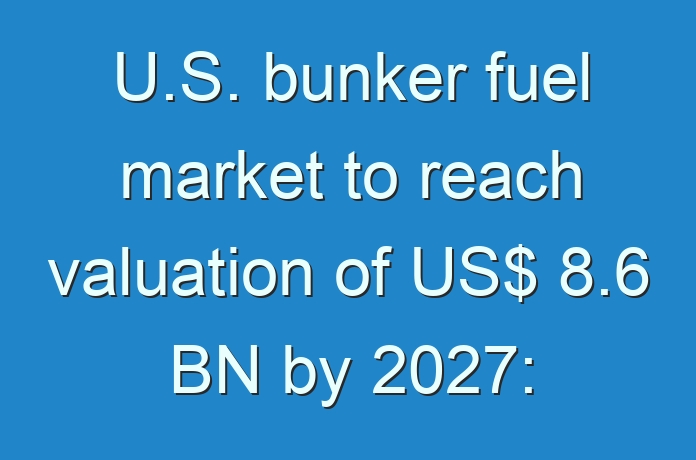
U.S. Bunker Fuel Market: Introduction
The bunker fuel market in the U.S. was valued at US$ 7.8 Bn in 2019 and is anticipated to expand at a CAGR of ~1% during the forecast period. Based on fuel grade, the IFO 380 segment held dominant share of the bunker fuel market in the U.S. in 2019, as IFO 380 is a widely used bunker fuel by fleet owners due to its lower price than other types of fuels. In terms of seller type, the leading independent distributors segment accounted for dominant share of the bunker fuel market in the U.S. in 2019. Leading independent distributors have well-established setup that includes blending facility, storage terminals, and own physical assets. Based on application, the tanker fleet segment constituted prominent share of the bunker fuel market in the U.S. in 2019, due to rise in demand for crude oil, petroleum products, chemicals, and liquid raw materials in various regions. The tanker fleet segment comprises specialized purpose-built vessels designed to carry liquefied petroleum gas (LPG) or liquefied natural gas (LNG) under pressure. The bunker fuel market in the east coast zone of the U.S. is likely to expand at a substantial pace during the forecast period, owing to rise in containerized shipments in the zone.
Request a Sample –
https://www.transparencymarketresearch.com/sample/sample.php?flag=S&rep_id=78498
Major Drivers of U.S. Bunker Fuel Market
The rise in international seaborne trade is boosting the bunker fuel market in the U.S. The seaborne trade in the country is performing well, supported by the upswing in the economy. Seaborne trade includes shipping, intercontinental trade, bulk transport of raw materials, and import/export of affordable food and manufactured goods. The increase in offshore exploration and production, due to rise in demand for resources such as crude oil, coal, steel, and iron, is estimated to propel the demand for bunker fuel in the near future. Rapid technological development has boosted oil & gas exploration activities at deep offshore locations and other marginal oil and gas fields. Companies supplying bunker fuel have strategically opened bunkering divisions in ports that are close to major offshore hydrocarbon basins, as bunkering requirements are significantly high for some offshore support vessels. Thus, growth in offshore exploration and production activities is projected to drive the bunker fuel market in the U.S. in the near future.
East Coast Zone Offers Lucrative Opportunities in U.S. Bunker Fuel Market
The East coast zone is anticipated to be a highly attractive zone of the bunker fuel market in the U.S. during the forecast period. The bunker fuel market in the zone is estimated to expand at a significant pace during the forecast period. The market in the east coast zone is being driven by rise in containerized shipments from East Asia. Charleston and Jacksonville have recorded large shipment gains among ports in the east coast zone. The west coast zone accounted for significant share of the bunker fuel market in the U.S. in 2019. Furthermore, the west coast zone has largest and busiest ports in the U.S.
Request for covid19 impact analysis –
https://www.transparencymarketresearch.com/sample/sample.php?flag=covid19&rep_id=78498
Prominent Developments in U.S. Bunker Fuel Market
On July 3, 2019, ExxonMobil introduced EMF.5, a range of engineered marine fuels developed ahead of the International Maritime Organization’s (IMO) global 0.50% sulfur cap. All fuels in this range are specifically engineered to help vessel operators comply with the 2020 regulations without compromising on quality. In October 2019, Total launched its first large liquefied natural gas (LNG) bunker vessel. The bunker vessel is expected to operate in Northern Europe and supply LNG to commercial vessels. The use of LNG sharply reduces emissions from ships, resulting in significant improvement in air quality, particularly for communities in coastal areas and port cities.
Competition Landscape of U.S. Bunker Fuel Market
The bunker fuel market in the U.S. is highly fragmented. Large-sized, multinational, and small-sized players dominate the bunker fuel market in the U.S. Major players operating in the bunker fuel market in the U.S. include BP, LUKOIL, BP SINOPEC MARINE FUELS., Chevron U.S.A. Inc., Exxon Mobil Corporation, Royal Dutch Shell plc, Aegean Marine Petroleum Network Inc., World Fuel Services Corporation, GAC, BUNKER HOLDING, and KPI BRIDGE OIL.
Buy now-
https://www.transparencymarketresearch.com/checkout.php?rep_id=78498<ype=S
U.S. Bunker Fuel Market: Segmentation
U.S. Bunker Fuel Market , by Fuel Grade
- IFO 380
- IFO 180
- MGO/MDO
- LS 380
- LS 180
U.S. Bunker Fuel Market, by Application
- Tanker Fleet
- Container Fleet
- Bulk & General Cargo Fleet
- Others (including Passenger Ferries and Cruise Ships)
U.S. Bunker Fuel Market, by Seller Type
- Major Oil Companies
- Leading Independent Distributors
- Small Independent Distributors
U.S. Bunker Fuel Market, by Zone
- East Coast Zone
- West Coast Zone
- Gulf of Mexico
More Trending Report-





